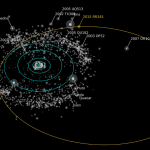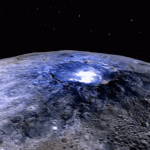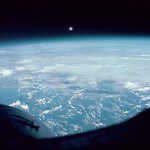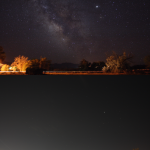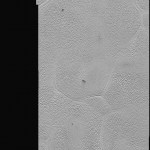Astronomy
"...innumerable stars, thousands of double and multiple systems, clusters in one blaze with their tens of thousands of stars, and the nebulae amazing us by the strangeness of their forms and the incomprehensibility of their nature, till at last, from the limit of our senses, even these thin and airy phantoms vanish in the distance." -Mary Fairfax Greig Somerville
When you look at an active, massive star-forming region like the Orion Nebula, you expect to find new stars dominating, blowing off the gas and eventually bringing the episode of star formation to an end. Previous visible light…
“Dwell on the beauty of life. Watch the stars, and see yourself running with them.” -Marcus Aurelius
Let there be light! You’d think that would be enough: that you form stars in the Universe, you see those stars in the Universe, and that tells you about what’s out there. If only it were that simple.
The dark nebula Barnard 68, now known to be a molecular cloud called a Bok globule. Image credit: ESO, via http://www.eso.org/public/images/eso0102a/.
In order to truly see the first stars, you need a lot more that just starlight: you need that light to be able to freely travel through space.…
"There have only been two true planets discovered since ancient times, and this would be a third. It's a pretty substantial chunk of our solar system that's still out there to be found, which is pretty exciting." -Mike Brown, on the possibility of Planet Nine
When most people think of the Kuiper belt, they think of a population of objects just beyond Neptune, with slightly larger, more elliptical and more inclined orbits. As new discoveries like the recent 2015 RR245 show, however, there are a great many additional objects in the scattered disk with different orbital parameters that are much…
"My eureka moment was in the dead of night, the early hours of the morning, on a cold, cold night, and my feet were so cold, they were aching. But when the result poured out of the charts, you just forget all that. You realize instantly how significant this is—what it is you’ve really landed on—and it’s great!" -Jocelyn Bell-Burnell, on the discovery of the first pulsar
Nearly 1,000 years ago, in 1054, a massive star in the constellation of Taurus, invisible at some 6,500 light years away, exploded in a type II supernova. Today, its remnant measures 10 light years across, while its inner core…
"It was the Venus I had prayed to, it was my prayer, though I had no such words. They filled my eyes with tears and my heart with inexpressible joy." -Ursula Le Guin
If you were to rewind the Solar System to the very beginning, with only imperceptibly different initial conditions, how often would Earth emerge looking like it does today: teeming with life? And how often would the other worlds -- Venus or even Mars -- emerge overflowing with stable, long-term life either instead or in addition to Earth?
Protoplanetary disks, which all solar systems are thought to form with, will coalesce into…
“Have you entered the springs of the sea? Or have you walked in search of the depths?” -Job 38:16
When NASA’s Dawn spacecraft discovered the existence of bright, white spots inside one of Ceres’ largest craters, the speculations ran wild, from water to aliens. Instead, it was determined that these highly reflective features are salts, likely deposited on Ceres’ surface fairly recently in this deep, less-than-100-million-year-old crater.
Image credit: NASA/JPL-Caltech/UCLA/MPS/DLR/IDA, converted from Nature Publishing Group press’s YouTube channel.
But new data, mostly in the infrared,…
“It used to be that Pluto was a misfit. Now it turns out that Earth is the misfit. Most planets in the solar system look like Pluto, and not like the terrestrial planets.” -Alan Stern
The combination of New Horizons and Hubble to work together allow us to create the longest-baseline parallax images of all time. Through this combination, we’ve managed to learn more about a distant, long-range Kuiper belt object -- in this case, (15810) 1994 JR1 -- than ever before.
New Horizons image of 1994 JR1, taken Nov. 2, was the then-closest-ever picture of a Kuiper Belt object. Image credit: NASA/…
"You can be the Moon and still be jealous of the stars." -Gary Allen
Earlier this week, NASA announced the discovery of Asteroid 2016 HO3, calling it Earth’s second moon. And it turns out that this is an object in a stable orbit, the same distance from the Sun as the Earth, that can be found revolving around our world at a distance between 38 and 100 times the distance from us to the Moon.
The orbits of all the known Potentially Hazardous Asteroids, as of 2013. This includes asteroids that have been gravitationally captured by the Earth-Sun system. Image credit: NASA/JPL-Caltech.
But that…
"There are two possible outcomes: if the result confirms the hypothesis, then you've made a measurement. If the result is contrary to the hypothesis, then you've made a discovery." -Enrico Fermi
Given the huge number of stars, planets, and chances at life that the galaxy and the Universe has given us, it seems paradoxical that we haven't yet encountered any form of alien intelligence or even life. The discoveries make in the field of exoplanet studies, particularly by the Kepler mission, make this an even bigger problem than we anticipated: more than 10^22 planets with Earth-like condition…
"Mozart's music is like an X-ray of your soul - it shows what is there, and what isn't." -Isaac Stern
When supermassive black holes have a large amount of matter fall onto them, they accelerate a large amount of the ionized material -- particularly electrons -- into high-velocity, bi-directional jets. In many cases, those jets of material collide with previously blown-off gaseous material and create high-energy X-rays.
A black hole more than a billion times the mass of the Sun powers this X-ray jet that's many thousands of light years long. Image credit: NASA / Hubble / STScI / Wikisky tool…
"If you've seen one gamma-ray burst, you've seen one gamma-ray burst!" -Common quote among gamma-ray burst astronomers, emphasizing how little we know about them.
When the first gravitational wave signal ever, GW150914, was directly detected, NASA’s Fermi GBM team shocked the world by announcing the detection of a high-energy burst of electromagnetic radiation. This was a huge surprise, because merging black holes shouldn’t have a bright gamma ray or X-ray flash associated with them!
Image credit: NASA, of an inspiral and merger of two massive, compact objects; illustration only.
A…
"It turned out that nature was very kind, and there appear to be many of these black holes in the Universe and we were lucky enough to see one." -Dave Reitze, executive director of LIGO
On September 14th, 2015, just days after turning on, the twin Advanced LIGO detectors detected the first gravitational wave signature: a merger between two black holes, of 36 and 29 solar masses. They inspiraled, they merged, and they lost 5% of their rest mass to gravitational radiation, sending ripples through the fabric of space due to Einstein’s E = mc^2. It raised a whole slew of questions: were these…
"In order for the light to shine so brightly the darkness must be present." -Francis Bacon
Recently, a team of international researchers has assembled the most comprehensive, up to date study on light pollution on Earth ever, including a full-Earth map of dark sky conditions or lack thereof. Its findings were disheartening but unsurprising, including the fact that 80% of Americans and 60% of Europeans cannot see the Milky Way.
The night sky from a rural (top) vs. urban (bottom) location. These are not extreme examples of pristine skies or of heavily polluted skies. Image credit: flickr user…
Check out our detailed interview with the famous and amazing Ethan Siegel.
We talk about the history of understanding the universe, why you should believe in Dark Matter even though it is obviously fake, why exploring uranus can lead to the discovery of amazing things, and more.
"The cosmic game changed forever in 1992. Before then, logic told us that there had to be other planets besides the nine (if you still count poor Pluto) in our solar system, but until that year, when two astronomers detected faint, telltale radio signals in the constellation Virgo, we had no hard evidence of their existence." -Thomas Mallon
For generations, if you wanted to know what the surface of the outermost known object in our Solar System -- Pluto -- looked like, you had to rely solely on your imagination. Sure, it was probably covered in ice, and large enough to pull itself into a…
"What's really exciting is what comes next. I think we're opening a window on the universe -- a window of gravitational wave astronomy." -Dave Reitze
On September 14, 2015, LIGO directly detected gravitational waves for the first time, from the inspiral-and-merger of two quite massive black holes. Despite the fact that no electromagnetic radiation signal was expected, the Fermi GBM instrument measured a high-energy X-ray event just 0.4 seconds after LIGO’s 200 millisecond detection occurred. According to NASA scientists working on the Fermi mission, there was just a 0.2% chance of a false…
"The self-same atoms which, chaotically dispersed, made the nebula, now, jammed and temporarily caught in peculiar positions, form our brains; and the 'evolution' of brains, if understood, would be simply the account of how the atoms came to be so caught and jammed." -William James
When stars like our Sun run out of fuel, they expand into red giants, start fusing helium in their cores, blow off their outermost layers very slowly, and then their insides die. They heat up even further, contract down to white dwarfs, and the intense ultraviolet light ionizes and illuminates the blown-off…
"By refocusing our space program on Mars for America's future, we can restore the sense of wonder and adventure in space exploration that we knew in the summer of 1969. We won the moon race; now it's time for us to live and work on Mars, first on its moons and then on its surface." -Buzz Aldrin
When the Curiosity Rover landed on Mars in August of 2012, it seemed that we had the ultimate successor to Opportunity in place. That older, over-engineered rover is still going after more than 12 years on the red planet, and Curiosity is leaps and bounds ahead in terms of technology: nuclear powered,…
"The first amazing fact about gravitation is that the ratio of inertial mass to gravitational mass is constant wherever we have checked it. The second amazing thing about gravitation is how weak it is." -Richard Feynman
One of the strangest, most novel predictions of Einstein's relativity is that mass would not only curve space, but that the curved space would act like a lens. Background light traveling past this mass would become magnified, distorted and stretched. In some cases, arc, multiple images or even perfect, 360º rings would occur.
This image illustrates a gravitational lensing…
"More days to come / new places to go
I've got to leave / it's time for a show
Here I am / Rock you like a hurricane!" -The Scorpions
On Earth, category 5 hurricanes cause devastation wherever they make landfall, bringing sustained winds, rain, destruction and -- in many cases -- casualties. But despite how strong and massive these storms can be, they're just peanuts compared to what happens on our Solar System's gas giants.
Jupiter's great red spot (from Cassini, imaged in 2000) and Earth (imaged from Apollo 17 in 1972), shown together for size comparison. Image credit: NASA / Brian0918 at…


